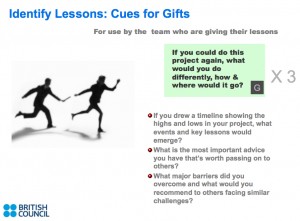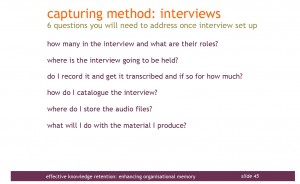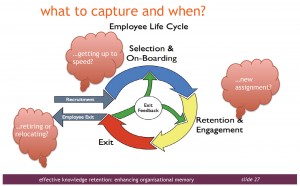A week back someone asked me for a bit of advice about getting projects off the ground so I thought I’d share this with her (and you). At the request of the Executive Chairman I’m doing a really interesting piece of work at the moment with a new management team. If we pull it off it will be a great example of how to embed Knowledge Management principles into a business with the aim of speeding up development and learning as we go.
theoretical and practical underpinnings
Successful project management is dependent in no small part on collaborative team working. Learning Before, Learning During and Learning After (core foundations of what is often called Knowledge Management) can transform the way project and management teams work and how they collaborate. Simple techniques associated with each step will ensure that what we learn as we progress is fed back into the way we work in the future. The techniques associated with each step are tried and tested across a variety of industries and cultures. We are going to begin by creating an environment and way of working that encourages collaboration and openness: where we all share in success and are able to identify and rectify potential failure.
the brief
The funding clock is ticking and ‘product’ (a prototype) has to be at an advanced
stage if not already delivered for Q3 2015.
In short, the new team has to ‘hit the ground running’ from January and rapidly
establish a modus operandi in the first 90 days to ensure:
- all issues around obstacles to delivery are capable of being surfaced in an open
and supportive manner; - a set of core behavioural norms including communication and a technical
collaborative infrastructure are established by the team for the team; - everyone understands their responsibilities, role and deliverables and is aware
of the strengths of the rest of the team; and - everyone celebrates successes and takes ownership of potential failure
My initial brief was along these lines:
…help create a collaborative team environment with a shared understanding of what needs to be done and by whom…
the backdrop
Without naming the client (I will call them Polyglot)) I can tell you:
- it’s space age stuff involving energy retention (so green and renewable)
- it’s a multicultural environment and none of the 6 ‘man’ team has English as a first language
- none of the team have worked on a project together
- they have ambitious targets to develop a working prototype
Each was chosen because of a specialism – PhD’s abound – and an ability to go beyond what’s conventional. But they have different backgrounds, cultures, outlooks and personal value sets. They are hungry and excited about the prospect of creating a product that can change the way we look at energy retention.
Ahead of the meeting I sent them an outline of the session and opened as follows:
You face a tremendously exciting and challenging 2015. A
new company, a new multinational team and a project that
has the potential to change the way energy is consumed,
stored and saved. Few organizations and the people who
work for them can look forward to the coming year with
such anticipation.
Project Mobilisation Meeting #1
Its Day Four and most of the team arrived on Day One. We’ve assembled at their new offices which is appropriately housed on a reseach park. In advance I asked each of the team to be thinking about a proud moment when they had enjoyed working in a team.
The aims of the half day session were:
- Begin building a Polyglot culture based on collaborative team working.
- Understand the respective strengths of the team members and Polyglot.
- Help kick off the ‘project’ with a shared understanding of the obstacles, deliverables and timing.
The agenda I worked up for the half day kick off session is below. What I can share is how the opening went (taken from the write up I produced):
Introductions
Everyone had a really interesting story to tell about him or herself and an astonishing array of experiences. Perhaps the most revealing was that nobody had English as his or her first language. We adopted this mantra as a way of overcoming potential misunderstanding:
‘I heard you to say…. and I understood you to mean….’
Further we agreed that whenever anyone did not understand a phrase or word they would seek clarification and record it on a white board along with a glossary of terms.
| item | who | comments |
| Introductions | Ask people to introduce themselves with their name and an interesting/unusual fact. Scene setting: why are we here, what the session is all about.give some examples of good (and bad) experiences | |
| Hopes & Fears | Exercise In 2 parts. Each person to write down on Postit notes:Why I joined? To plenary and call out.Then 3 hope and 3 fears and put up on the wall. | |
| ‘when you look at things differently’ | An exercise designed to get people thinking about different perspectives.Split into 3 teams and give each a paper with one of 3 ‘professions’. Ask them to jot down notes about the room through that ‘lens’. Back to plenary for call out and learning’s. | |
| My proudest team moment | PC to ask each person to tell his or her story. JM to note down words for each person that sum up emotions, skills & knowledge, outcomes, behaviours. | |
| How can we ensure the project fails? | This exercise (a Reverse Brainstorm) will surface barriers/obstacles and solutions. Split into two teams; ask them what can they do to make sure we fail to meet the deadlines and quality standards. | |
| What would you tell your Dad? | Ask each person to write down a response to this ‘over dinner question’: So tell me what is it you are doing?Then get everyone to come and put his or her ‘offerings’ onto the wall. In plenary for discussion and agreement. | |
| And finally: ‘Homework’ | set the task: present an outline project plan on Friday 16th January. NB We will decide the composition of the teams in advance. There will be no guidance. |






